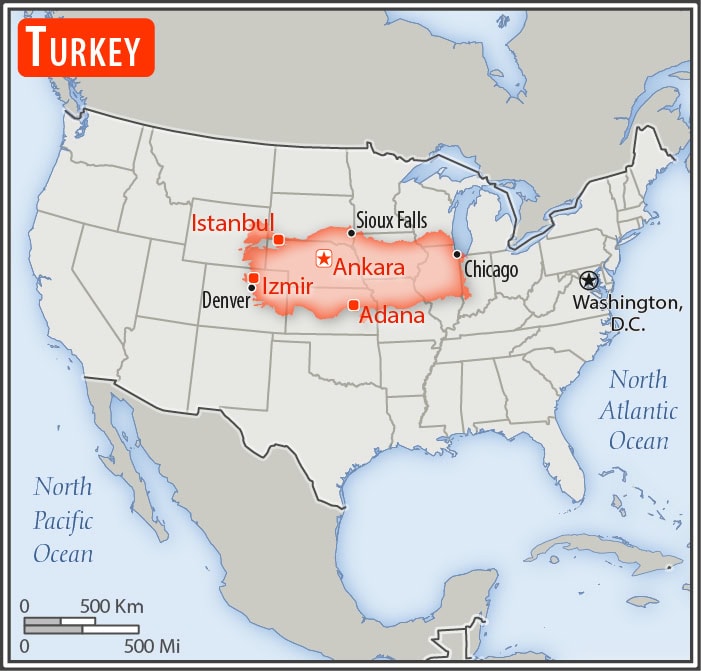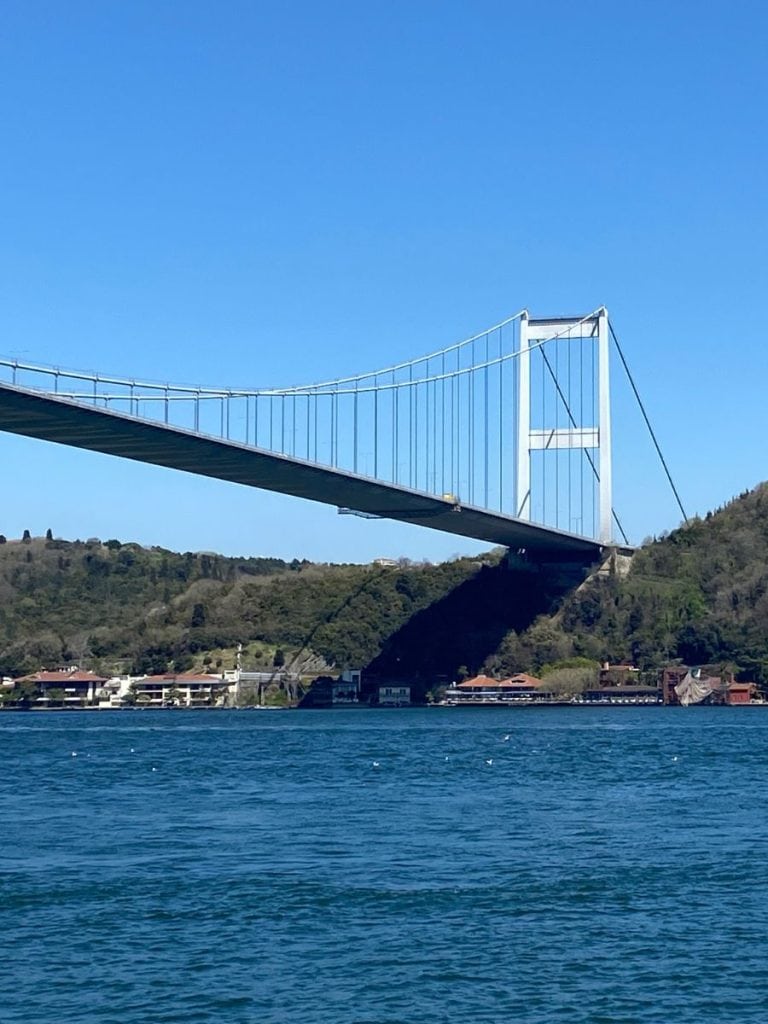How Big is Turkey? A Comprehensive Guide to its Geography, Climate, & Demographics

The Art of Living in Turkey contains affiliate links and is a member of the Amazon Services LLC Associates Program. If you make a purchase using one of these Amazon links, I may receive compensation at no extra cost to you. See my Disclaimers for more information.
“How big is Turkey?” is a common question that I will answer in this blog post.
TL;DR Stretching across both Europe and Asia, Turkey ranks as the 37th largest country in the world, covering an impressive 783,356 square kilometers. That’s about 1.25 times larger than Texas!
Turkey is more than just a point on the map; it’s a country of towering mountains, fertile valleys, and over 7,000 kilometers of coastline, offering an incredible diversity of landscapes and climates.
Having lived here for more than five years, I’m continually amazed by the diversity within Turkey’s borders.
From snow-capped peaks and ancient ruins to modern cities and pristine beaches, Turkey is a collection of experiences that typically you can find across an entire continent.
I’ve explored 6 of Turkey’s 7 unique regions, and I’m excited to share how each offers its own distinct culture, landscapes, and climate.
I know it can be challenging to visualize just how vast and varied a place is if you haven’t been there yourself.
That’s why I want to paint a picture of Turkey’s landscapes for you, so let’s dive in and discover the incredible scope of this country together.
(geography stats taken from Wikipedia)
Modern Turkey: Country Profile
Modern Turkey became the Republic of Turkey in 1923 because of a man named Mustafa Kemal Ataturk.
His work to establish Turkiye after the fall of the Ottoman Empire is still revered and adored to this day.
In order to understand the enormity of something, we must put it into perspective. So, let’s bring some context to the topic of Turkiye’s size.
Although Turkey ranks as the 37th largest country globally, size becomes quite relative, when you’re straddling Europe and Asia.
With a total area close to 302.535 square miles (800,000 km²), the country has more to show than just your average kebobs and baklavas.
That’s bigger than Texas (268.820 square miles), people—and Texans love to say everything’s bigger there!
Side note: that makes me think of one time I took my car into the shop when I lived in Texas. My tiny Mazda Protege was parked between two massive trucks. My only thought was “Everything is bigger in Texas.” 😂
When you factor in the nearly 5,000 square miles (8,000 km²) of coastline, you start to realize that the grandeur of the Republic of Turkey is one to reckon with.
This country boasts a multitude of incredible attributes in terms of its tangible size, topographical variety, and diverse weather patterns.
In this article on winter specifically, I explain a bit more about the different climate zones within Turkey.
Have these numbers surprised you? Well, hold on to your fez hats, there’s more.

Geography & Landscape of Turkey
Turkey, the bridge between two continents, provides an appealing blend of Eastern and Western traditions due to its unique position.
The country’s 302k square mile profile means that is bigger than Spain but smaller than Congo. As I said in the introduction it is roughly 1.25 times the size of Texas.
The Thrace and Marmara Region – A European Corner
A small portion of Türkiye, about 3%, lies in southeast Europe known as ‘Eastern Thrace’ or ‘Thrace.’
The region covers about 23,764 km² and is home to cities like Edirne, Tekirdağ, and part of the famous Istanbul. This region further extends to the Marmara region, a significant link between Europe and Asia, resting on the Bosphorus.
Its location around the Sea of Marmara gives it a unique attribute in the form of a mild and wet climate, differing notably from the harsh weather in other parts of the country.
The Mysterious Anatolia
The remaining 97% of Turkey lies in Asia and is called ‘Anatolia.’
This region is divided into seven geographical areas: the Marmara (carries over into the European side), Aegean, Mediterranean, Black Sea, Central, Eastern, and Southeastern Anatolia.
Anatolia boasts plateaus, rugged mountains, and beautiful coastlines.
Central Anatolia, often referred to as the heartland of Turkey, is known for its steppe landscape, whereas Eastern Anatolia is where you’ll find the severe terrain of high mountains like Mount Ararat.
One can’t forget Cappadocia in Central Anatolia, which rivals lunar landscapes with its unique fairy chimneys and rock formations.
The Mediterranean and Aegean regions, meanwhile, offer picturesque coastlines and olive groves overlooking the azure blue sea.
If you venture to the Black Sea region, you’ll be greeted by spectacular mountain ranges and dense forests.
This region has a more temperate oceanic climate, allowing luscious green landscapes to thrive.
From the rough terrain of the east to the beautiful beaches of the south, from the luscious north to the western cosmopolitan cities, Turkey’s various landscapes corroborate it isn’t small by any measure.

Turkey’s Climate
The size of Turkey brings with it significant climatic diversity, adding another alluring element to its rich geographical tapestry.
This diversity arises from Turkey’s unique position straddling two continents, being partially landlocked as well as coastlines, and the wide range of geographical features it encompasses.
Transitional Climate Between Continents
Generally, Turkey is subjected to seven different climate types, but predominantly, it experiences a Mediterranean climate along its coastal regions and a harsher Continental climate in the interior areas.
Mild Coastal Areas
The coastal regions facing the Aegean and the Mediterranean Seas have typical Mediterranean weather.
This weather is characterized by hot, dry summers and mild, wet winters.
Typically November, December, and January are the wettest months, and June, July, and August are the driest months.
The famous tourist destinations of Antalya, Bodrum, and Izmir fall into this zone, making these areas delightful holiday destinations.
If you’re a fan of hot and humid beach days you will especially enjoy it in the summer. If you’re like me and prefer a bit milder, your shoulder seasons are the time to go.

Inland Areas: The Contrast of Harsh Cold
In stark contrast, the Anatolian plateau experiences a more extreme climate.
Inhospitably cold and snowy winters matched with hot and dry summers are the norm in this central part of the country.
Cities like Ankara and Konya, to name a few, fall into this zone and exhibit significant temperature differences between seasons.
The Lush and Rainy Black Sea Region
The Black Sea region is different yet again, where warm, wet summers and cool, damp winters result in the most consistent precipitation across the country.
This relatively rainy region nourishes dense forests and tea plantations.
Here you’ll find cities like Sinop, Trabzon, and Rize along the verdant coastline.
Climate-induced Allure
Taking climate under consideration, Turkey’s size isn’t merely a measure of geographical span but also the vast range of weather patterns influencing the country.
These vast differences, from one end to another, necessarily contribute to the appeal and mystique of Turkey, drawing in tourists and weather enthusiasts alike.
What is special about this, IMO is that regardless of what you’re looking for, you can probably find it in Turkey!

The Demographics of Turkey
While the size of Turkey is impressive, this wide-open land is even more remarkable when you consider the diversity among the Turks that call it home.
In fact, the blend of cultures and historical influences across different regions provides as much variety as the geography itself.
Population Breakdown by Region
These numbers are from 2015 as they have yet to be updated…I’ll work on doing some more research on Tuik and get you some updated numbers soon.
Marmara Region: With the thriving city of Istanbul, the Marmara region houses nearly 30% of Turkey’s population.
With its cross-continental appeal and rich history, Istanbul alone is home to almost 18 million people.
Aegean Region: Known for its warm and welcoming climate, the Aegean Region, which includes the prominent city of Izmir, carries a population of over 10 million.
Mediterranean Region: At just under 10 million people it has fewer people and more land than the Aegean Region. It is also known as the Turkish Riviera.
Central Anatolia: With the country’s capital, Ankara, this region sustains a population of around 13 million people, despite its harsher climate and geographic obstacles.
Black Sea Region: The cooler, rainy northern coast supports around 8 million people. The local economy of this area relies heavily on tea and hazelnut farming.
Eastern and Southeastern Anatolia: Despite its rugged terrain and more severe weather, these regions carry a significant portion of the population with distinct cultural identities.
Rural and Urban Mix
Turkey’s areas of settlement are also widely varied, ranging from cosmopolitan cities like Istanbul and Ankara to more rural communities found in the Anatolian heartland or the rugged southeastern regions.
This mix of urban and rural cultures significantly adds to Turkey’s size regarding its cultural versatility and vibrance.
Then to take it a step further, you add in the edges of Turkey that touch other countries and you find this magical blend of cultures.
A Sense of Culture as a Measure of Size
The blend of East and West is perhaps most obvious in the nation’s population.
The diversity of ethnicity, language, and culture in Turkey’s population echoes the country’s physical volume and geographical diversity.
These intertwined facets give Turkey its dynamic identity — a vibrant blend of tradition and modernity, history and innovation, conservativeness and cosmopolitanism; fitting perfectly into its expansive geographical area.
FAQs about Turkey, a country that spans Europe and Asia
Exactly how big is Turkey in square miles?
Turkey spans approximately 302,535 square miles. It is strategically situated as a land bridge between Europe and Asia Minor, contributing to its cultural and demographic diversity.
How does the size of Turkey compare to other countries globally?
Turkey is the 37th largest country in the world in terms of land area. It’s larger than countries like France and Spain, but smaller than countries like Argentina and Kazakhstan.
What is the influence of the climate on the size perception of Turkey?
Turkey’s varied climates contribute to the diverse allure of the nation. The variation from temperate oceanic weather in the north to hot Mediterranean climates in the south offers different experiences, providing the impression of a much larger country.
Can you provide a demographic breakdown of Turkey’s population?
Turkey’s population exceeds 85 million people, spread across different regions. The majority of the population resides in Istanbul, while other prominent cities include Ankara, İzmir, and Antalya.
How is Turkey’s geographical position influencing its size and traction it gets?
Turkey’s position as the bridge between Europe and Asia widens its cultural influence, enhances its strategic importance, and attracts international attention. This often makes it appear larger in the global landscape.
final thoughts
So now I hope there is no confusion left and you have a solid grasp of just how big Turkey actually is.
With its strategic geographical location, Turkey stands as the link between Europe and Asia, contributing to its cultural and demographic diversity.
Its vast and varied landscape, stretching across differing regions, adds considerably to its overall size and diverse geography.
Weather variations across the regions, ranging from temperate oceanic weather on the north coast to the hot Mediterranean climate in the south, add unique aspects and allure to its size.
Not to mention the complex demographics of Turkey, with a population exceeding 85 million and bordering 8 different countries including Syria, Armenia, and more.
Together, these attributes give us a multidimensional view of Turkey.
So, when asked ‘How big is Turkey’, we see it’s not merely a question of land area – it’s about the rich tapestry of geography, climate, and demographics that shape this vibrant country.
Read more:
- Plan to take a trip to Northern Cyprus while you’re here?
- Don’t forget to grab a Turkish eSIM before you come
- If you’re not convinced yet, here are more reasons to visit Turkey
- Planning your trip? Here are a couple different 1 week itineraries
- If you’re coming in April, don’t miss the Tulip Festival
- Looking at the fall and wondering about Thanksgiving?
Turkey Vacation Basics
When I plan a trip these are the websites I use. I hope they help you plan your next adventure as well!
FLIGHTS: I am a huge fan of Skyscanner and WayAway.
VISAS: You can use the free e-visa portal here but for a few extra dollars you can use iVisa and someone else will handle any issues that may come up.
E-SIM: When I traveled to SE Asia I discovered e-sims and I’m never going back. Airalo has been easy and cheap!
TRAVEL INSURANCE: I use TravelInsurance.com for my trips abroad.
CAR RENTAL: I have loved working with Discover Cars when I rent cars in country.
AIRPORT TRANSFERS: I have used these transfers many times and they are always great. If you’d like more options, I also recommend GetTransfers.com as they allow you to compare companies.
ACCOMMODATION: Find the best Turkey hotel deals on Booking.com.
CITY TOURS & DAY TRIPS: You can browse GetYourGuide’s website to find just the tour you’re looking for! We also recommend the MegaPass for major cities.
